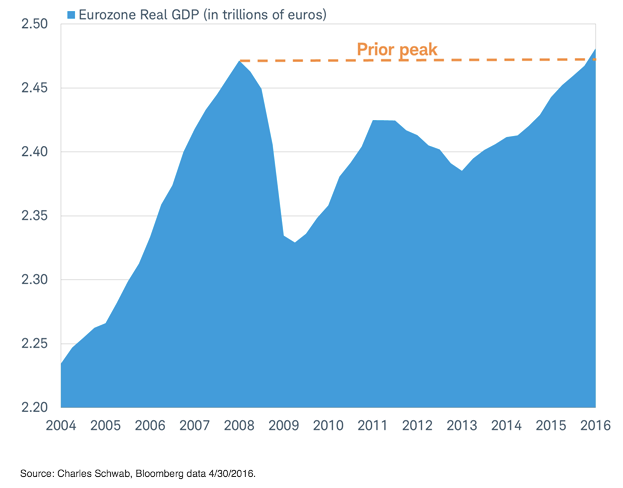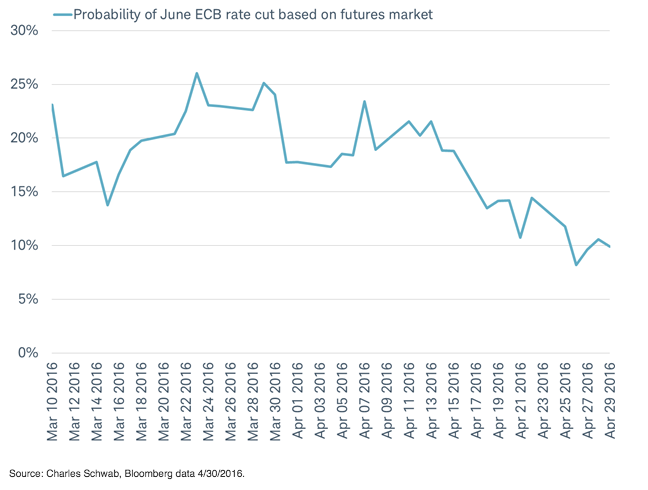Key Points
- Strong first quarter growth has pushed Eurozone GDP back above its prior peak eight years ago.
- Many companies noted solid growth in Europe during the ongoing first quarter earnings reporting season.
- Better growth has lowered market expectations for additional rate cuts by the European Central Bank and helped Europe’s stocks lead the developed markets higher in April.
Eurozone GDP growth surprised to the upside in the first quarter with a strong +0.6%, or an annualized 2.4% quarterly growth rate (for comparison to the way U.S. GDP growth is reported). This lifted the Eurozone economy to a new all-time high eight years after the Q1 2008 peak, as you can see in the chart below. This good news is supported by reports of first quarter earnings results and future quarters’ outlook provided by economically-sensitive companies. It is also welcome news for the European Central Bank (ECB) which is running out of new options to spur growth.
Eurozone GDP has finally fully recovered after more than eight years

The pace of growth in Europe in the first quarter doubled the pace in the prior quarter, but exactly where this growth came from will not be detailed until June 7. However, gathering insights from some of the individual European countries that also reported GDP last week, revealed details of broad growth across the major components. For example, GDP in France was a solid +0.5% (not annualized), a rebound from the weakness in the prior quarter, supported by strong growth in consumer spending of +1.2%. This is following the -0.1% contraction in the fourth quarter (which may have been impacted by the November Paris terror attacks). This strong growth helped lift imports by 0.5%. Additionally, fixed investment grew by +0.9%, continuing the solid growth seen in the fourth quarter.
Spain posted a strong 0.8% GDP growth rate, maintaining its rapid pace of growth. While no details were available, confirmation of Spain’s strong growth could be seen in comments from many companies this earnings season: Nestle, Heineken, Carrefour, Coca-Cola, Sodexo, Aena, and Randstad.
While Spain stood out, many companies noted solid European growth overall. Earnings reports and comments from companies from a variety of economic sectors have generally confirmed the improving pace of economic activity in Europe. For example:
- Transportation - Data from Spanish airport operator Aena show air passenger traffic grew 14% in Spain. Data provided by the Zurich airport reveals 4% growth despite a strong Swiss franc and Rome’s airport reported 4% growth in EU passenger traffic.
- Construction - Volvo raised truck order and construction equipment forecasts.
- Employment - Netherland staffing company Randstad reported solid first quarter demand.
On a local currency basis, estimates for earnings over the next year have been rising for companies in the MSCI Euro Index (which tracks Eurozone stocks) in recent weeks. In fact, in dollar terms they are up to the highest level this year, having risen 6% from their low point in the first quarter.
The growth in Europe in the first quarter was impressive especially considering the challenges of:
- a roller-coaster stock market,
- a rising currency weighing on exports,
- mounting concerns over the U.K. potentially leaving the European Union,
- the refugee crisis,
- the adverse impact on the financial sector of the ECB’s negative interest rate policy.
It is possible that GDP growth in the second quarter may ease somewhat from the strong pace of Q1, but remain solid.
ECB impact
Strong growth is a big relief to the ECB who went all out at the last meeting on March 10 meeting by announcing new actions to spur growth, including:
- a cut in interest rates,
- an increase in monthly “QE” asset purchases,
- adding corporate bonds to the “QE” program,
- a new series of targeted longer-term refinancing operations (TLTROs) to provide funds to banks.
The last two announced measures haven’t even been implemented yet and may provide a further tailwind to growth. The economic outlook would probably need to deteriorate sharply to compel policy makers that more action is needed. Market expectations for additional rate cuts have fallen, as you can see in the chart below. Since the last rate cut on March 10, the chance of a rate cut in June fell from around 1 in 4 to less than 1 in 10, according to the interest rate futures market.
A June rate cut by the ECB is looking less likely

The outlook for further action by the ECB is fading despite inflation remaining weak and the euro continuing to rise versus the dollar. The return of a negative rate of inflation in the Eurozone is not a surprise; the ECB forecasts negative inflation in the second quarter. While the strength in the euro versus the U.S. dollar is not welcome, since it can further lower inflation and negatively impact exports, the euro currently stands only about 3% above the average level of the second quarter of last year. This move is small relative to the 20% year-over-year moves to the up and downside over the past five years in the value of the euro and therefore may not offset the positive economic momentum and other stimulus measures in place and on tap for the coming months.
The improving economic and profit momentum is helping lift Europe’s stocks. The MSCI Euro Index outperformed other developed stock markets including the United States and Japan (measured by the MSCI United States Index and MSCI Japan Index) in April and from the 2/11 low through the end of April.
Jeffrey Kleintop is senior vice president and chief global investment strategist at Charles Schwab & Co.